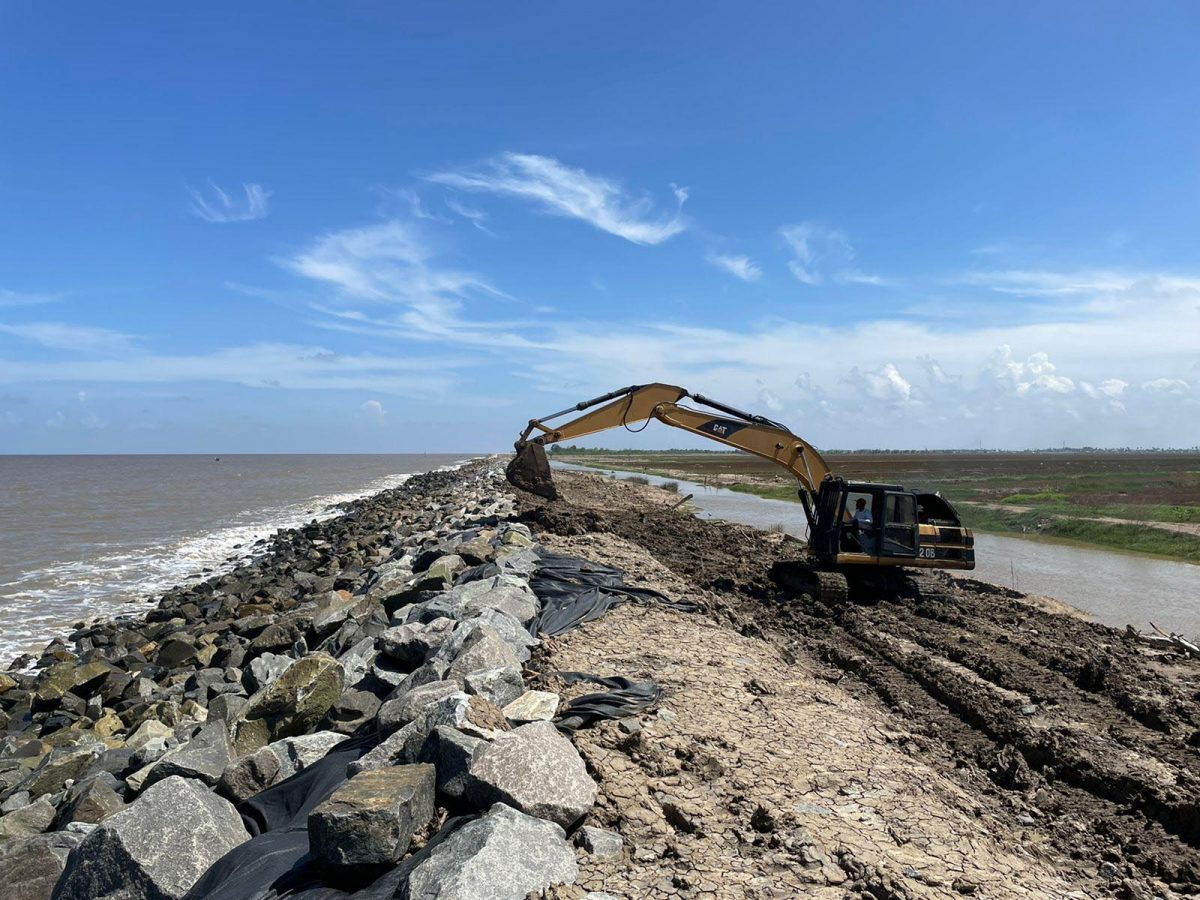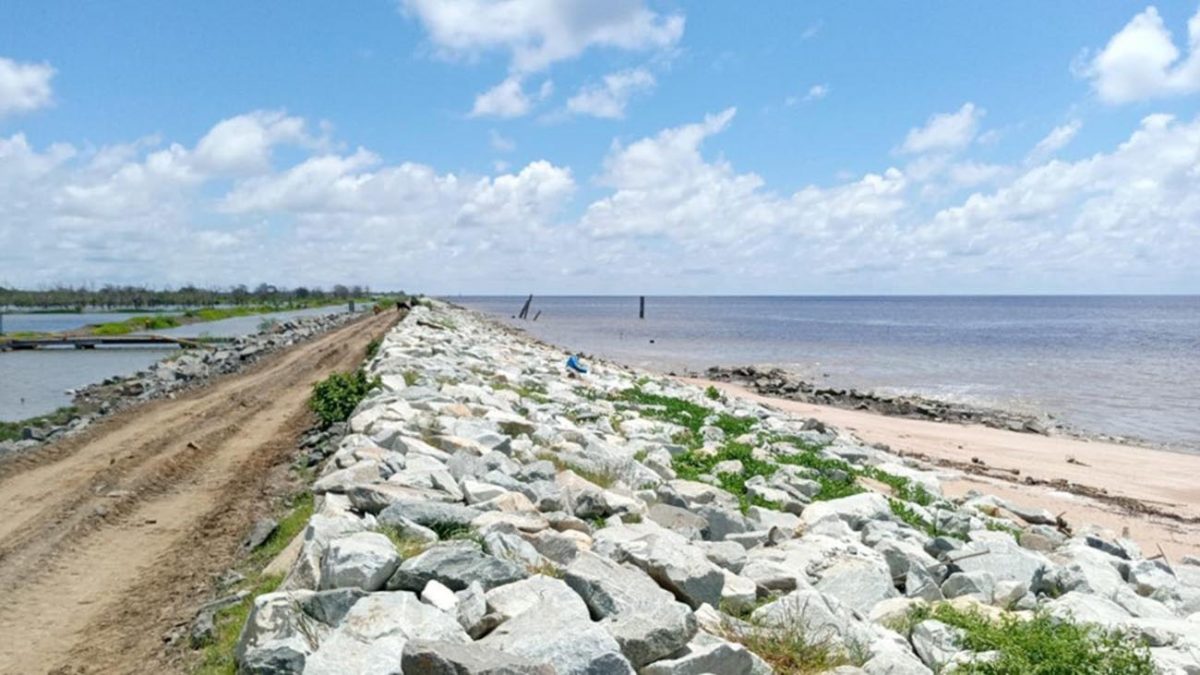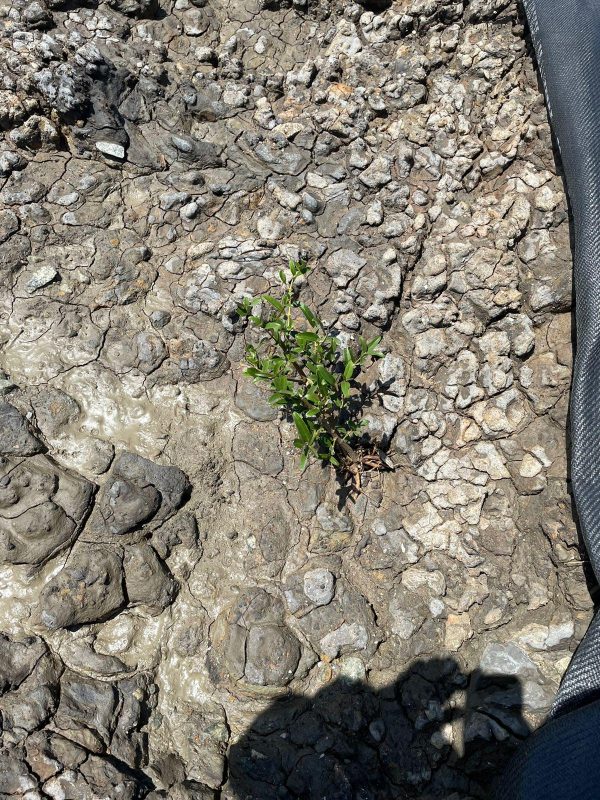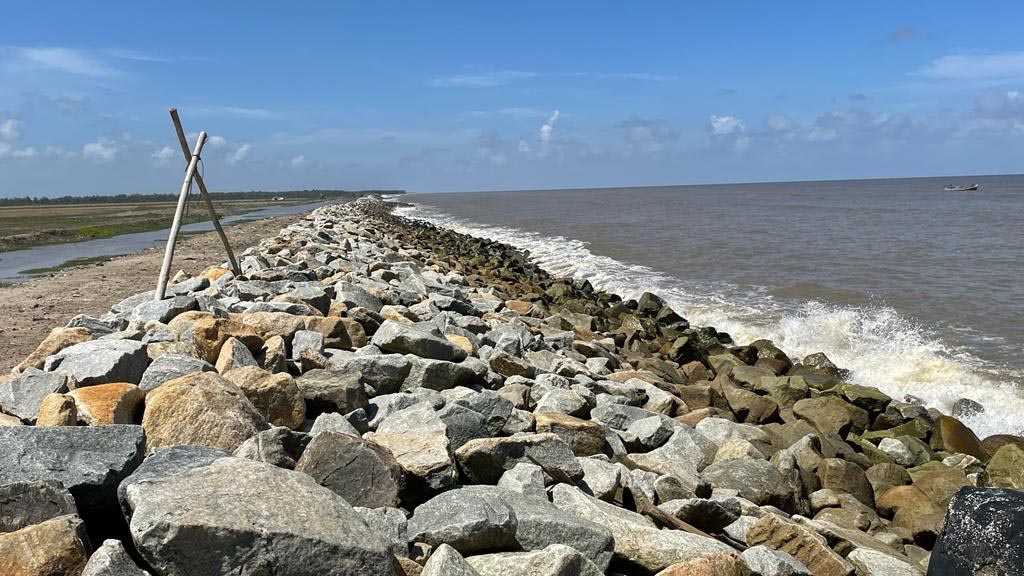Two years after ferocious Atlantic Ocean waves battered the Mahaicony shoreline, destroying millions of dollars’ worth in rice and livestock, over five kilometres of rock-armoured sea defence has been constructed to defend against a possible recurrence.
Within the last year, six major projects for the permanent revetment of 2,260 metres were awarded to contractors by the Ministry of Public Works’, Sea and River Defence Department and all have been completed.
Of the $1.3 billion 2021 budgetary allocation for works to the stretch of the sea defence, $1.2 billion has been expended to shore up the sea defences.
Two major projects for the construction of 1,000 metres of permanent rock-armoured revetment are currently being undertaken and should be completed soon.
Minister of Public Works Juan Edghill in a response to queries by this newspaper, stated that 5.2 kilometres of permanent revetment have been completed within Fairfield and Bygeval on the East Coast Demerara.
A document from the minister stated that the department will continue to monitor the entire Mahaicony shoreline and will deploy a rapid response team to respond to any breach and prevent possible flooding in the communities.
It was noted that flood protection works are required for an additional 2 kilometres of shoreline outside the current zone in 2022.
“The measure to be implemented by the Minister in the near future will include the execution of multiple contracts focused on rock armour revetment construction works and upgrading of existing rock armour revetments and earthen embankment (within) the zone of completed works,” the prepared response stated.
The targeted areas for these interventions are between Bygeval and Belvedere and Fairfield and Zealand, Mahaicony.
The shoreline has been subjected to intense erosion due to an extreme, cyclic foreshore erosion in the area. As a result of powerful waves during the erosion cycle, mud banks that once held mangroves in position, which served as a buffer to the powerful waves, were washed away. This resulted in a complete depletion of mangroves from the battered shoreline.
The sea defence, which separates the farmlands from the ocean, initially broke away in 2019 on a July afternoon resulting in severe flooding which threatened crops and livestock, farmers had told this newspaper. Since February 2019, farmers had reported that the stretch of sea defence between Fairfield and Bygeval had been eroding but nothing was done to prevent major flooding.
During a visit to a few of the locations earlier this month, Stabroek News observed that in the area of Dantzig, Content, and Fairfield, 100% of works have been completed while in Mes Delices, over 90% of works have been completed.
In addition to the construction of sea defences, upgrading of the sea barrier has also been underway along Dantzig and Fairfield.
However, the waves remain ferocious and this has resulted in some boulders being washed into the ocean. A worker at Mes Delices told this newspaper that it has been a challenge for them as the impact of the waves on a few occasions shifts the boulders. When this occurs, they have to either replace boulders or recover boulders from the ocean and re-position them.
At one point in 2020, during the execution of emergency works, a contractor, this newspaper was told, was unable to carry out works. This was due to the spring tides and unfavourable weather conditions.
Stabroek News learnt that the contractor was only able to execute works for four days before the rains began and was forced to move from the site due to the soggy state of the sea dam. The works executed during that period were washed away after being pummelled by waves from the Atlantic during the commencement of the spring tide.
The rip-rap sea defence has been constructed using huge boulders and polyethylene geotextile fabric. The current construction has seen the sea defence earthen barriers being constructed higher than what has traditionally obtained.
The current defence carries a height of 12 feet but despite this, during high tides the ocean still manages to slightly overtop the defence.
Vulnerable
Meanwhile, residents in the communities are vulnerable to the floods if another breach occurs and told this newspaper that they are grateful for the works that have been completed. While they feel a bit safer, they are still taking the necessary precautions to protect their investments.
Chairman of the Woodlands Farm/ Fairfield Neighbourhood Democratic Council, Cleveland Ramsammy, told this newspaper that they are a little concerned since they have noticed the boulders shifting.
And while they have been making checks on the progress of the works, he said that they do not have the full bills of quantities to as to be able to scrutinise the work being done.
“We don’t know if the right materials are being used and if they are securing it well… I do believe in projects like this they should have a local mind with them because we have an understanding of how the area is… the engineers will come with the science but we have the knowledge of how things work here,” he contended.
Ramsammy had previously advocated that government makes provision for affected residents to be relocated after experiencing the effects of rising sea levels. The community leader also expressed concern that new areas of erosion are being observed at Quakers Hall, Zeelugt Bath and De Kinderen. He said that he has already communicated these new areas to the authorities and only hopes work will commence soon to prevent any breaches.
Neil Machado, farmer and community activist, told this newspaper that he is somewhat relieved knowing that the floods from any breaches have been minimized. Others in the neighbourhood have also expressed the same sentiments.
Machado related that since the completion of the sea defence they have not faced any major flooding and many farmers have been trying to return to their farmlands.
However, he is contemplating whether to return and cultivate his rice lands that were inundated during the 2019 and 2020 floods.
The cultivated lands are separated by the Bellamy Canal from the Atlantic Ocean and was the first area to be affected by the flooding. Over 1,500 acres of rice were threatened and farmers lost millions of dollars. Since the floods, no farmer has returned to the lands as the saline content was high on the lands after being inundated for a protracted period by the saltwater from the ocean.
Just after accepting his ministerial portfolio, Edghill had instructed that a third contractor be engaged to fix the breached sea defence in view of the urgency of the situation at Dantzig, Mahaicony.
A recently published World Bank Climate Report highlighted that Guyana is among the countries in the Caribbean that face the greatest risk of a retreating shoreline and stands to lose 53 metres of its shoreline by 2050 if the current climate trend continues and the sea level increases.
Based on its modelling system, the World Bank explained that mainland countries like Guyana and neighbouring Suriname are expected to be heavily affected by the sea level rise which would lead to increased flooding and possible coastal displacement.
According to the report, Guyana, Suriname, and Trinidad and Tobago face the largest risk of a retreating shoreline, with an estimated retreat of 53, 58 and 43 metres, respectively by 2050 under Representative Concentration Pathways (RCP 4.5). When looking at risk towards the end of the century in high climate change scenarios (RCP 8.5), the countries with the highest expected annual people exposed are, Dominica with 1.8% of the population exposed, Guyana 4.7%, Suriname 2.8%, and St. Martin 2.9%.
It is estimated that sea levels will rise one to four feet by the end of the century and with parts of Guyana’s coast sitting as low as one metre below sea level at high tide, it is cause for concern.
The World Bank report estimates that Guyana stands to lose 65 metres of its sandy beaches by 2050.
Based on the general findings of the report, the World Bank team proposed three broad recommendations to increase the resilience of the region. The first recommendation is to increase government efficiency, which means that in a context where governments do not necessarily have the capacity or the resources to spend more on resilience, they have many options to spend better and to deliver higher levels of resilience with the same levels of resources that they have.
During an engagement at the University of Guyana’s 21st installment of its Turkeyen and Tain Talks “Green Building for Resilient Future Cities,” held in November last year, then Minister of Public Infrastructure David Patterson, announced that $14 billion was needed between 2020 and 2022 to effect “urgent” repairs to 32.9 kilometres of Guyana’s sea defence.
He had explained that if government fails to execute these works, communities across the coast will suffer a fate similar to that of Mahaicony, East Coast Demerara.
New breaches develop easily, he said, before pointing out that as one area is fixed, the water diverts and undermines other weak sections of the defence, thereby exposing it to rapid erosion.









